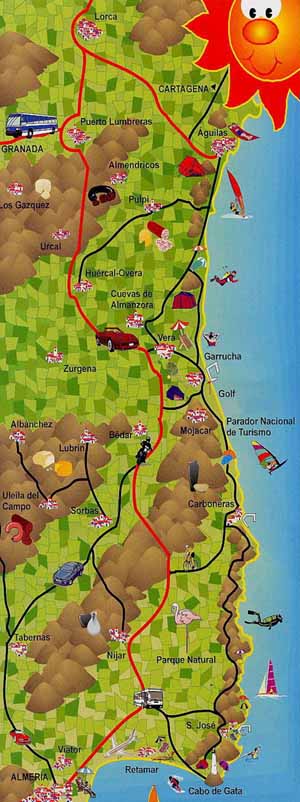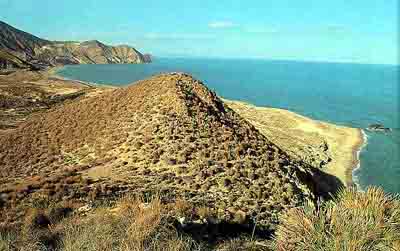
Costa de Almeria
The Costa de Almeria is completely unspoilt. To the east of Almeria we find the rugged and desolate coast of the Cabo del Gato-Nijar natural park. This is an arid desert landscape and the annual rainfall here is less than 200mm. It is sparsely populated, few villages and a very low population density. Visitors feel a sense of exploration here as many of the coves can only be reached on foot. This area is particularly popular with nature lovers. The most popular coastal village is San José
West of Almeria is the highly developed tourist resorts of Roquetas de Mar and Aqua Dulce. These have all the facilities of any modern resort to support the package holiday market.
At the north of the Costa de Almeria is the naturist beaches of Vera, a number of new complexes are being constructed here. A little further south is Mojacar which successfully combines the popular beach holiday with the hillside white village that tourist love to explore.
Almeria city is worth a visit with the Alcazaba castle overlooking the metropolis.
To the west we find the developing complex of Almerimar with Marinas, golf, hotels and many other facilities.
The old fishing port town of Adra lies further west. In spite of the interesting castle and assorted archeological remains, it is often missed by tourists travelling along the coastal motorway to or from the Costa Tropical.
CABO DE GATA (NATURE PARK)
At the rugged southeastern corner of Spain, the peninsula known as Cabo de Gata – officially known as the Cabo de Gata-Nijar Nature Park – is, with its 29,000 hectares, Andalucia's largest coastal Nature Park. Contrasting dramatically with the arid, volcanic inland mountains– the Sierra de Cabo de Gata – the shoreline is composed of sand dunes and salt pans, making it the leading wetland of Almeria Province.. The coast is composed of jagged cliffs and small, hidden coves with white sand beaches, slashed everywhere with parched gullies. The pristine waters of the peninsula are ideal for underwater photography and all types of fishing, as well as sailing and windsurfing, while the inland areas are ideal for mountain biking and land vehicle excursions.


MOJACAR
This spectacular Moorish fortress town stands on a towering crag overlooking a shore graced by pristine beaches and the sparkling waters of the Mediterranean, which has a curious distinction all of its own: American cartoonist Walt Disney is said to have been born here, before emigrating with his parents to the United States.
Like many other villages in south-eastern Spain, in the 1960's Mojacar had become a ghost town, since most of its active inhabitants had moved north to find work in the factories of the Barcelona region, and further afield. To attract new residents, the town's mayor gave land away to anyone who promised to build, and within a year picturesque Mojacar had become a thriving art colony. Mainstream tourists and holiday-makers were also later attracted by the beauty and charm of the place and the following decades saw the development of its shoreline, with the construction of hotels and villas.
Fortunately, the village has still retained much of its original character,
with its Moorish fortress called El Torreón and the Arch of Luciana,
as well as the honeycomb of whitewashed, winding streets, each of which
seems to lead the traveller to a lookout over the sparkling Mediterranean.
